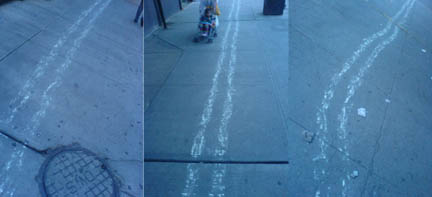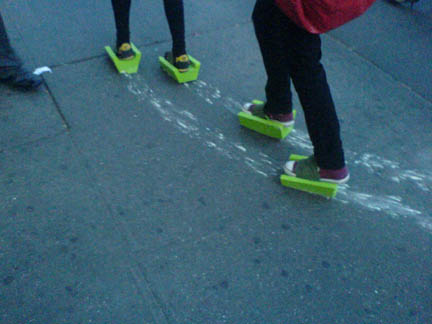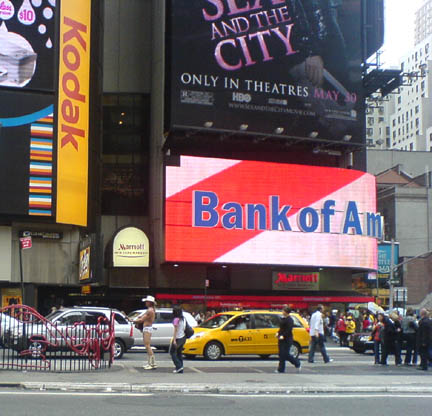main: May 2008 Archives
Returning to New York City after a 20-year journey in Seattle and South Florida. New York taught me how to think art.
Psychologically, NYC has changed dramatically. Signs in the subway remind parents to keep baby carriages off the escalator. Street territory has been reapportioned for small plazas to hangout or walk more comfortably. Only a few of the former down-and-out residents of the street remain. The permanent abandonment of former brick tenements has ceased. Dark windows signal the wrecking ball and renewal, not the hopelessness.
Of course, the dark hopeless territories still exist, but many, many people can live and work in Manhattan rarely encounter the misery. In the 1980s when I organized artistic critiques of the civic abandonment, all peoples in Manhattan had to divert their hearts away from the people of the streets or the five stories of broken glass. We artists were saddened and angry at the diversion- but that anger sparked thought, energy and action through art or body or both.
On Wednesday, I revisited one of the most dangerous Manhattan zones in the 1980s - the meatpacking district. Today, the pristine storefronts are so numerous and trendy that both Samantha and Carrie from "Sex in the City" shopped there. I thought I was walking in some kind of strange dream where the fairy godmother swooped her wand and sparkled the filth into beautiful clothes for everyone.
One art gallery, Leo Keating Gallery, had sponsored an art event to raise money for the new Highline park that will open in a few months. The use of the old elevated rail tracks was a favorite student architecture project in the 80s and 90s. One of architect Steven Holl's very early theoretical projects proposed housing on the tracks. Now after ten years of advocacy and fund raising, the Highline will become a public park - an important part of the literal greening of Manhattan.
To raise cash, the gallery was selling fluorescent green chalk shoes by Julia Mandle. Earlier in the month, she put shoes on various students from nearby schools and they drew a path on the sidewalk to the Highline. A simple idea to tell the children, their friends and their parents that the Highline was coming to the neighborhood. On the night of the gallery opening, she and a friend where making an apparently arbitrary path through the new glamour of the meat packing district. Following the path that evening would lead you to the gallery or to her on the shoes.
The gallery did not have significant posters about the Highline and the artist was not carrying any information with her. This absence of information is a very New York thing that does not happen in other parts of the USA. As I remember from days past, the New York art world believes that explanation apparently degrades the artwork. Converting the thing from art to advertising. 
My new paying job is to create a consistent public art program for the Times Square Alliance. Advertising, not art, dominates Times Square. So my new work takes me straight to conflict between the instinct for ambiguous poetic connotations of art and the directive for the clear targets of advertising. 
Yet the visitors to Times Square desire the unexpected. The protective judgments about art back home are abandoned in Times Square and the energy of strangeness is embraced. Instead of secrecy of naughty personal acts in the Vegas slogan "What happens here, stays here", a visit to Times Square might generate a celebratory slogan like "Look what happened to me here". The visitors snap pictures of every new billboard and ask a friend to record their strange encounters with Naked Cowboy or the two Statues of Liberty that graced Times Square today with a background of Peruvian flutes. What better place could exist for public art to receive the full acceptance of all types of folks?

Blogroll
AJ Ads
AJ Blogs
AJBlogCentral | rssculture
Terry Teachout on the arts in New York City
Andrew Taylor on the business of arts & culture
rock culture approximately
Laura Collins-Hughes on arts, culture and coverage
Richard Kessler on arts education
Douglas McLennan's blog
Dalouge Smith advocates for the Arts
Art from the American Outback
For immediate release: the arts are marketable
No genre is the new genre
David Jays on theatre and dance
Paul Levy measures the Angles
Judith H. Dobrzynski on Culture
John Rockwell on the arts
Jan Herman - arts, media & culture with 'tude
dance
Apollinaire Scherr talks about dance
Tobi Tobias on dance et al...
jazz
Howard Mandel's freelance Urban Improvisation
Focus on New Orleans. Jazz and Other Sounds
Doug Ramsey on Jazz and other matters...
media
Jeff Weinstein's Cultural Mixology
Martha Bayles on Film...
classical music
Fresh ideas on building arts communities
Greg Sandow performs a book-in-progress
Exploring Orchestras w/ Henry Fogel
Harvey Sachs on music, and various digressions
Bruce Brubaker on all things Piano
Kyle Gann on music after the fact
Greg Sandow on the future of Classical Music
Norman Lebrecht on Shifting Sound Worlds
publishing
Jerome Weeks on Books
Scott McLemee on books, ideas & trash-culture ephemera
theatre
Wendy Rosenfield: covering drama, onstage and off
Chloe Veltman on how culture will save the world
visual
Public Art, Public Space
Regina Hackett takes her Art To Go
John Perreault's art diary
Lee Rosenbaum's Cultural Commentary
Tyler Green's modern & contemporary art blog
